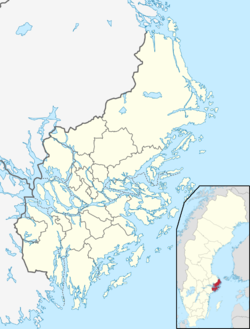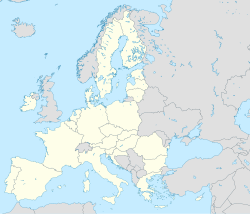
Back Стокҳольм Abkhazian Stockholm ACE Stockholm Afrikaans Stockholm ALS ስቶኮልም Amharic Estocolmo AN Stoccholm ANG ستوكهولم Arabic ܣܛܘܩܗܘܠܡ ARC سطوكهولم ARY
Stockholm | |
|---|---|
|
| |
| Nickname(s): Sthlm, Eken, the Venice of the North, the Venice of Scandinavia[1] | |
| Coordinates: 59°19′46″N 18°4′7″E / 59.32944°N 18.06861°E | |
| Country | Sweden |
| Province | Södermanland and Uppland |
| County | Stockholm County |
| First mention | 1252 |
| Charter | 13th century |
| Government | |
| • Mayor | Karin Wanngård (S) |
| Area | |
| 188 km2 (73 sq mi) | |
| • Urban | 381.63 km2 (147.35 sq mi) |
| • Metro | 6,519 km2 (2,517 sq mi) |
| Elevation | 28 m (92 ft) |
| Population | |
| 984,748 | |
| • Density | 5,200/km2 (14,000/sq mi) |
| • Urban | 1,617,407 |
| • Urban density | 4,200/km2 (11,000/sq mi) |
| • Metro | 2,415,139 |
| • Metro density | 370/km2 (960/sq mi) |
| Demonyms |
|
| GDP | |
| • Metro | €171.269 billion (2021) |
| Time zone | UTC+1 (CET) |
| • Summer (DST) | UTC+2 (CEST) |
| Postal code | 100 00-199 99 |
| Area code | +46-8 |
| Website | start |
Stockholm (Swedish: [ˈstɔ̂kː(h)ɔlm] ⓘ)[10] is the capital and most populous city of Sweden, as well as the largest urban area in the Nordic countries. Approximately 1 million people live in the municipality,[11] with 1.6 million in the urban area,[12] and 2.4 million in the metropolitan area.[11] The city stretches across fourteen islands where Lake Mälaren flows into the Baltic Sea. Outside the city to the east, and along the coast, is the island chain of the Stockholm archipelago. The area has been settled since the Stone Age, in the 6th millennium BC, and was founded as a city in 1252 by Swedish statesman Birger Jarl. The city serves as the county seat of Stockholm County.
Stockholm is the cultural, media, political, and economic centre of Sweden. The Stockholm region alone accounts for over a third of the country's GDP,[13] and is among the top 10 regions in Europe by GDP per capita.[14] Considered a global city,[15] it is the largest in Scandinavia and the main centre for corporate headquarters in the Nordic region.[16] The city is home to some of Europe's top-ranking universities, such as the Karolinska Institute (medicine), KTH Royal Institute of Technology, Stockholm School of Economics and Stockholm University.[17] It hosts the annual Nobel Prize ceremonies and banquet at the Stockholm Concert Hall and Stockholm City Hall. One of the city's most prized museums, the Vasa Museum, is the most visited museum in Scandinavia.[18] The Stockholm metro, opened in 1950, is well known for the decor of its stations; it has been called the longest art gallery in the world.[19] The city was the host of the 1912 Summer Olympics, and has played host to several other international sports events since.[20]
Stockholm is Sweden's primary financial centre, one of the largest in Scandinavia, and hosts several of Sweden's largest companies. Furthermore, the headquarters of most of Sweden's largest banks are in Stockholm. Stockholm is one of Europe's major tech centres; the city has sometimes been called Europe's innovation hub.[21] The Stockholm region has a GDP of around $180 billion,[22] and Stockholm County has the highest GDP per capita of all counties in Sweden.[23]
Stockholm is the seat of the Swedish government and most of its agencies,[24] including the highest courts in the judiciary,[25] and the official residences of the Swedish monarch and the Prime Minister. The government has its seat in the Rosenbad building, the Riksdag (Swedish parliament) is seated in the Parliament House,[26] and the Prime Minister's residence is adjacent at the Sager House.[27] Stockholm Palace is the official residence and principal workplace of the Swedish monarch, while Drottningholm Palace in neighbouring Ekerö serves as the Royal Family's private residence.[28]
- ^ "20 Famous Cities You Can Visit Without Breaking The Bank – TripAdvisor Vacation Rentals". TripAdvisor Vacation Rentals. Archived from the original on 5 February 2016. Retrieved 10 February 2016.
- ^ "Localities 2010, area, population and density in localities 2005 and 2010 and change in area and population". Statistics Sweden. 29 May 2012. Archived from the original on 16 January 2013.
- ^ "citypopulation.de", www.citypopulation.de, archived from the original on 5 November 2023, retrieved 5 November 2023
- ^ "Folkmängd i riket, län och kommuner 30 juni 2021 och befolkningsförändringar 1 april–30 juni 2021. Totalt". Statistics Sweden. Archived from the original on 18 August 2021. Retrieved 5 September 2021.
- ^ "Folkmängd i riket, län och kommuner. Totalt". SCB. Archived from the original on 9 August 2016. Retrieved 2 July 2016.
- ^ "Stockholm". Nationalencyklopedin (in Swedish). Archived from the original on 10 March 2014. Retrieved 30 January 2014.
- ^ "Folkmängd per tätort och småort 2010, per kommun" (XLS) (in Swedish). Statistics Sweden. 20 June 2013. Archived from the original on 3 March 2016. Retrieved 2 February 2014.
- ^ "Tätorter i Sverige". Archived from the original on 23 August 2023. Retrieved 12 March 2024.
- ^ "Gross domestic product (GDP) at current market prices by metropolitan regions". ec.europa.eu. Archived from the original on 15 February 2023.
- ^ Hedelin, Per (1997). Norstedts svenska uttalslexikon. Stockholm: Norstedts.
- ^ a b "Folkmängden per månad efter region, ålder och kön. År 2000M01 - 2021M12". SCB. Archived from the original on 5 April 2020. Retrieved 1 March 2022.
- ^ Statistics Sweden [SV "Statistiska centralbyrån"] (SCB) (24 November 2021). "Statistical urban areas 2020, population, land area, population density [SV "Statistiska tätorter 2020, befolkning, landareal, befolkningstäthet"]". Urban areas and small localities [SV "Tätorter och småorter"] (in Swedish). Archived from the original on 27 September 2024. Retrieved 27 September 2024.
- ^ "Finansiella sektorn bär frukt—Analys av den finansiella sektorn ur ett svenskt perspektiv" (PDF). Government of Sweden. Archived from the original (PDF) on 28 July 2014. Retrieved 19 July 2014.
- ^ "Regional GDP per capita in the EU in 20 10: eight capital regions in the ten first places" (PDF). Eurostat. 2013. Archived from the original (PDF) on 3 April 2013. Retrieved 19 July 2014.
- ^ "The World According to GaWC 2020". GaWC - Research Network. Globalization and World Cities. Archived from the original on 24 August 2020. Retrieved 31 August 2020.
- ^ Olshov, Anders (2010). The location of nordic and global headquarters 2010. Malmö: Øresundsinstituttet. p. 197. OCLC 706436140.
Stockholm is the main centre of headquarters in the Nordic region
- ^ "World University Rankings 2011–12: Europe". TSL Education Ltd. Archived from the original on 1 August 2014. Retrieved 19 July 2014.
- ^ "Find out how to visit Scandinavia in this complete guide". www.nordicvisitor.com. Archived from the original on 18 October 2023. Retrieved 18 October 2023.
- ^ "Stockholm's underground subway art". BBC. Archived from the original on 6 April 2014. Retrieved 19 July 2014.
- ^ "Stockholm 1912 Olympic Games | Olympic Records, Sweden & Athletics | Britannica". www.britannica.com. Archived from the original on 19 April 2021. Retrieved 18 October 2023.
- ^ "Tech Start-ups Secure Sweden's Title as the European Silicon Valley". European Company Formation | Company Registration Europe. 23 August 2021. Archived from the original on 24 October 2023. Retrieved 28 October 2023.
- ^ "Stockholm: GDP 2021". Statista. Archived from the original on 18 October 2023. Retrieved 17 October 2023.
- ^ "Regional GDP - Regionfakta". www.regionfakta.com (in Swedish). Archived from the original on 18 October 2023. Retrieved 17 October 2023.
- ^ "Allt fler myndigheter hamnar i Stockholm" (in Swedish). Riksdag & Departement. 27 April 2012. Archived from the original on 1 May 2012. Retrieved 1 February 2014.
- ^ "Bondeska palatset" (in Swedish). National Property Board of Sweden. Archived from the original on 4 February 2014. Retrieved 2 February 2014.
- ^ "How the Riksdag works". The Riksdag. Archived from the original on 3 January 2014. Retrieved 2 February 2014.
- ^ "Sagerska huset" (in Swedish). National Property Board of Sweden. Archived from the original on 19 March 2019. Retrieved 2 February 2014.
- ^ "Royal palaces and residences". www.kungahuset.se. Archived from the original on 23 October 2023. Retrieved 21 October 2023.










